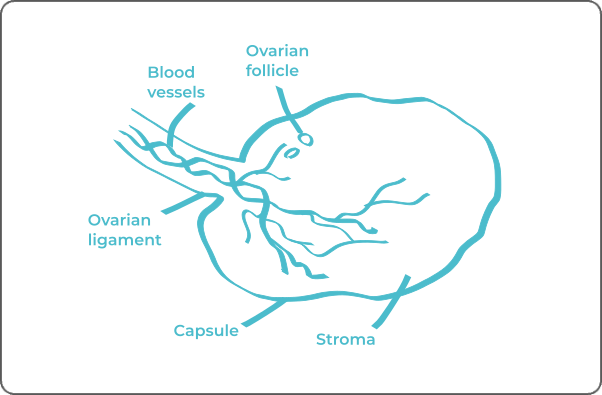Home › Biological sample › Cancer › Ovarian
Ovarian cancer biological samples
For research applications
The development of drugs and diagnostic tests for the treatment and detection of ovarian cancer requires conducting studies on biological samples obtained from patients with ovarian cancer.
A brief overview of the various types of ovarian cancer and how the services offered by Labtoo contribute to accelerating research and development projects in the pharmaceutical industry.


Are you looking for biological samples from ovarian cancer patients?
What are ovarian tumors?
The ovaries are crucial organs in the female reproductive system, responsible for two main functions: the production of eggs essential for reproduction and the secretion of hormones, including estrogen and progesterone, which regulate the menstrual cycle and influence female characteristics.
Ovarian cancer is generally divided into two distinct categories: Epithelial tumors and non-epithelials tumors
Epithelial tumors
Epithelial tumors originate from the outer lining of the ovary, known as the epithelium. This group includes various subtypes, with the most common being serous carcinoma.
Other subtypes include mucinous carcinoma, characterized by mucus production, clear cell carcinoma, and endometrioid carcinoma.
Non-epithelial tumors
These tumors encompass all cancers derived from non-epithelial cells.
Ovarian non-epithelial tumors include stromal tumors, developed in the connective tissue supporting the ovary, as well as germ cell tumors, arising from germ cells responsible for gamete production, and sex cord-stromal tumors forming in the sex cord cells.
| Type of Cancer | Cell of Origin | Frequency |
|---|---|---|
| Serous Carcinoma | Ovarian Epithelium | ≈ 50 - 70% |
| Mucinous Carcinoma | Ovarian Epithelium | ≈ 3 - 10% |
| Endometrioid Carcinoma | Ovarian Epithelium | ≈ 10 - 20% |
| Clear Cell Carcinoma | Ovarian Epithelium | ≈ 5% |
| Stromal Tumor | Connective Tissue Supporting the Ovary | ≈ 5 - 10% |
| Germ Cell Tumor | Germ Cells | ≈ 15 - 20% |
| Sex Cord-Stromal Tumor | Sex Cord Cells | Rare |

Ovarian cancer has the ability to spread to other organs through metastasis. Organs most commonly affected by ovarian cancer metastases include the fallopian tubes, uterus, bladder, peritoneum, as well as other abdominal organs. This complex spread often influences the stage at which cancer is diagnosed and, consequently, the choice of therapeutic approaches.
Explore Labtoo's Service for Your Biological Sample Research
Labtoo assists you in sourcing biological samples from ovarian cancer patients. Our team manages the entire project of transferring biological materials from inception to sample delivery.
- Feasibility assessment of sample availability or clinical collection from referenced clinical centers
- Validation of regulatory aspects
- Establishment of a contractual framework
- Dispatch of desired samples under appropriate conditions
- Transfer of associated clinical data
- Additional analytical and experimental services
Types of available samples
Fresh tissues
After a tumor resection or a biopsy, a pathologist can decide whether the tissue sample can be used for research. Labtoo can organize the conditioning and shipment of fresh ovarian cancer tissue in 24-48 hours after surgery.
Frozen tissues (OCT and FF)
Similarly to fresh tissue, once the tissues are cleared for research, the clinical site can freeze and keep the frozen ovarian cancer tissue samples at -80°C or in liquid nitrogen for ulterior use.
FFPE Tissues
Pathologists typically embed the biopsies and resections in paraffin. FFPE blocks of ovarian cancer tissues can be used later for research.
Adjacent Healthy Tissues
Tumor resections typically include healthy adjacent ovarian tissue during the process. This tissue can later be used for research and act as controls for diseased tissues.
- Plasma or Serum from ovarian cancer patients
- PBMC (Peripheral Blood Mononuclear Cells)
- Whole Blood
- Leukapheresis
- Urine
- Feces
- Other
Typical associated clinical data
-
- Age
- Gender
- Ethnicity
- TNM Classification
- Undergone Treatment
- Medical Imaging
- HIV/HBV/HCV status
- Mutations
- Other Data (upon request)

Labtoo identifies clinical sites that can prepare and transfer sample collections tailored to your specific project needs.
Contact our team to discuss your project.
Send your request to our team:
The stages and grades of ovarian cancer
The stage and grade of cancer are commonly used together to provide a comprehensive assessment of the disease and guide optimal treatment.
The determination of the cancer stage primarily relies on the TNM classification, which evaluates the tumor size (T), involvement of lymph nodes by cancer cells (N), and the presence of metastases in other parts of the body (M). Concurrently, the grade provides an indication of the degree of differentiation of cancer cells.
Regarding grades, denoted from 1 to 3, Grade G1 indicates well-differentiated cells resembling normal cells, Grade G2 represents moderately differentiated cells, and Grade G3 indicates poorly differentiated cells, suggesting faster and potentially more aggressive growth.
For ovarian cancer, the stages are defined as follows:
Stage 1 A
The tumor is only in one ovary, and the capsule surrounding the ovary is intact.
Stage I B
Tumors are in both ovaries, and the capsule is intact.
Stage I C
Tumor(s) in one or both ovaries.
Either the capsule is damaged, cancer cells are observed on the ovarian surface, or cancer cells are in the peritoneal cavity.
Stage II A
Cancer is present in one or both ovaries, and the tumor has invaded the uterus or fallopian tubes or both.
Stage II B
Cancer is present in one or both ovaries, and the tumor has invaded other organs in the lower pelvic area.
Stage III
Cancer is present in one or both ovaries or has originated in the peritoneum.
Cancer has spread to areas outside the pelvis.
Stage III A
Cancer has spread to retroperitoneal lymph nodes, and/or microscopic metastasis has migrated outside the pelvic region.
Stage III B
Extensive spread to the peritoneum outside the pelvis and to the intestine.
Stage III C
Cells have invaded distant areas of the peritoneum, possibly reaching the peritoneum lining the digestive organs.
However, the tumor has not infiltrated the organs.
Stage IV
Cancer has spread to different parts of the body, leading to the formation of metastases.

Rare forms of ovarian cancer
Occasionally, rarer forms of ovarian cancer occur. These include:
-
Mixed epithelial and mesenchymal tumors
Also known as carcinosarcoma, these tumors are composed of both epithelial and mesenchymal cells. They are rare but aggressive.
-
Clear cell tumors
This is a subtype of epithelial carcinoma, known for its aggressive nature. The cells of these tumors have a clear or translucent appearance under the microscope.
-
Immature teratomas
This is a rare category of germ cell tumors. Immature teratomas have cells that have not achieved normal differentiation, and more closely resemble embryonic or fetal cells.
Ovarian cancer treatments and advances
Treatment of ovarian cancer depends on the type of cancer, its stage, and the patient's physical condition. The main therapeutic modalities for treating this type of cancer include:
-
Surgery: Surgery remains the first option for treating ovarian cancer. Often assisted by laparoscopy or laparoscopy, the procedure most frequently involves the removal of both ovaries and the fallopian tubes. Depending on the stage of the disease, the uterus and nearby lymph nodes may also be removed.
-
Chemotherapy: Chemotherapy uses cytotoxic drugs to target and eliminate cancer cells. It may be administered before or after surgery, or as a primary treatment to control tumor growth (palliative administration).
-
Targeted therapies: These drugs target specific abnormalities present in cancer cells. In the context of ovarian cancer, they are often used either to inhibit the formation of tumor blood vessels (for example, with bevacizumab) or to block tumor enzymes involved in the repair of tumor abnormalities (for example, with olaparib).
Immunotherapy, which involves stimulating the immune system to fight cancer cells, may also be considered but is currently at the research stage.




